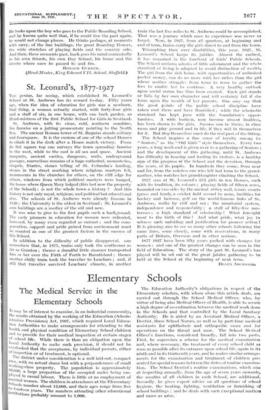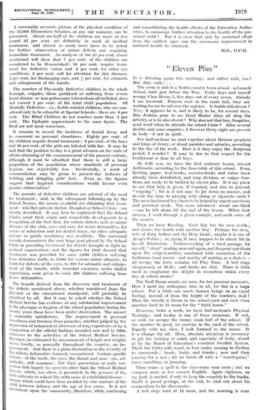Elementary Schools
The Medical Service in the Elementary Schools
IT may be of interest to examine, in an industrial community, the results obtained by the working of the Education (Admin- istrative Provisions) Act, 1907, which required Local Educa- tion Authorities to make arrangements for attending to the health and physical condition of Elementary School children and to provide for their medical inspection at certain stages of school life. While there is thus an obligation upon the Local Authority to make such provision, it should not be overlooked that the acceptance, by individual parents, either of inspection or of treatment, is optional. The district under consideration is a well laid-out, compact area, with no actual slums but with a preponderance of small working-class property. The population is approximately 80,000, a large proportion of the occupied males being em- ployed in casual labour. There is little or no employment of ma,, flied women. The children in attendance at the Elementary Schools number about 12,000, and their ages range from five to fourteen years. The numbers attending other educational insfrtutions probably amount to 1,000.
The Education Authority's obligations in respect of the Elementary scholars, with whom alone this article deals, are carried out through the School Medical Officer, who, by virtue of being also Medical Officer of Health, is able to secure a high degree of co-ordination between the medical work done in the Schools and that controlled by the Local Sanitary Authority. He is aided by an Assistant Medical Officer, a Dentist, three School Nurses, as well as by part-time medical assistants for ophthalmic and orthopaedic cases and for operations on the throat and nose. The School Medical Officer's functions, considered broadly, fall into two parts. First, he supervises a scheme for the medical examination and, where necessary, the treatment of every school child as soon as possible after its entrance upon school life, again in its ninth and in its thirteenth years, and he makes similar arrange- ments for the examination and treatment of children pre- sented for special reasons between the dates of routine examina- tion. The School Dentist's routine examinations, which aim at inspecting annually, from the age of seven years onwards, the mouths of all children in each School, are additional. Secondly, he gives expert advice on all questions of school hygiene, the heating, lighting, ventilation or furnishing of school buildings ; and he deals with such exceptional matters and cases as arise. A reasonably accurate picture of the physical condition of the 12,000 Elementary Scholars, at any one moment, can be presented. About one-half of the children are more or less sound; 25 per cent. ate definitely in need of medical treatment, and almost as many more have to be noted for further observation of minor defects not requiring immediate treatment. An analysis of the 25 per cent. above mentioned will show that 7 per cent. of the children are considered to be ill-nourished : 10 per cent. require treat- ment for defective vision and 2 per cent. for other eye conditions, 3 per cent. call for attention for skin diseases, 2 per cent. for discharging ears, and per cent. for adenoids and enlargement of the tonsils.
The number of Physically Defective children in the whole borough, cripples, those paralysed or suffering from severe heart disease or non-pulmonary tuberculosis all included, does not exceed 2 per cent. of the total child population. Of Mentally Defective—i.e., feeble-minded children, who are con- sidered only to be educable at Special Schools—there are -8 per cent. The Blind Children do not number more than •1 per cent. The Epileptic approximate to the same figure. The Deaf are not more numerous.
It remains to record the incidence of dental decay and to comment on personal cleanliness. Eighty per cent. of the children require dental treatment ; 3 per cent. of the boys and 30 per cent. of the girls are infested with lice. It may be said that the position to-day is a great advance on the state of affairs obtaining at the commencement of the present century, although it must be admitted that there is still a large proportion of the population whose standards of personal hygiene are regrettably low. Incidentally, a word of commendation may be given to present-day fashions of bobbing and shingling girls' hair. Even so, the figures suggest that hygienic considerations would favour even greater abbreviation!
The parents of defective children are advised of the need for treatment ; and, in the subsequent following-up by the School Nurses, the means available for obtaining that treat- meat—whether private doctor, Hospital orSchool Clinic—are clearly described. It may here be explained that the School Clinics owed their origin and remarkable development to a recognition of the fact that, for certain defects such as minor diseases of the skin, eyes and ears, for lesser deformities, for errors of refraction and for dental decay, no other adequate private or public machinery was available. The statistical records demonstrate the very large part played by the School Clinic in providing treatment for defects brought to light by medical examination ; and the figures for 1926 showed that treatment was provided for some 3,000 children suffering from defective teeth, to 3,000 for various minor ailments, to 1,600 for defects of the eyes, to 100 for adenoids and enlarge- ment of the tonsils, while remedial exercises, under skilled supervision, were given to sonic 200 children suffering from lesser deformities.
The benefit derived from the discovery and treatment of the defects mentioned above, whether considered from the physical or the educational standpoint, will probably be admitted by all.. *But it may be asked whether the School Medical Service has evidence of any substantial improvement in the physique or hygiene of the school population during the twenty years these have been under observation. The answer is eminently satisfactory. The improvement in personal cleanliness and freedom from parasites, whether judged by the impression of independent observers of long experience or by a comparison of the official findings recorded now and in 1908, witnesses to the activities of the School Medical Service. Physique, as estimated by measurement of height and weight, shows locally, as generally throughout the country, an im- provement. And there is a plain diminution in the severity of the rickety deformities formerly encountered. Certain specific defects---of the teeth, the eyes, the throat and nose—are, ad- mittedly, still common ; but their prevention or early cor- rection falls largely to agencies other than the School Medical Service, which, too often, is presented, in the persons of the little entrants to school life, with cases of established disease-- disease which could have been avoided by wise nurture of the child between infancy and the age of five years. Is it not incumbent upon the community, therefore, while continuing
and consolidating the health efforts of the Education Autho- rities, to encourage further attention to the health of the pre- school child ? For it is clear that only by sustained effort from the earliest ages can the maximum improvement in national health be attained.
M.D., D.P.H.



























































 Previous page
Previous page